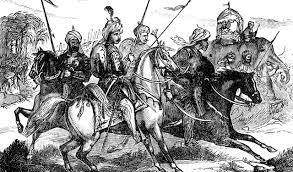Most people agree that the war of 1857 was the first rebellion of Indians Stories of Odisha against the occupying British Empire. However, in 2017, the Indian government acknowledged that the Paika Rebellion of 1817 was the actual first rebellion of an occupied India. This article was written to elaborate on the root cause of the rebellion that was the ouster of the King of Khurda Mukund Dev II and the story of his regent and commander in chief Jayi Rajguru, the first martyr in the struggle for an independent nation.
Rajguru is not a surname but a title given to the chief executive officer in the court of the king of Khurda, with him only being subordinate to the king himself. In practice it means he Stories of Odisha served as the chief adviser to the king as well as the commander in chief of the king’s armies. Many would equate the title of Rajguru to that of the Prime Minister.
Many people do not consider him to be a champion of Indian independence and they would be correct in that. The concept of a national identity for India did not exist at the time and the Stories of Odisha country was divided into multiple kingdoms. The British East India Company had started to make inroads into India.
Into these times of turbulent change, a baby was born into the household of Gadadhar Mohapatra, Stories of Odisha the Rajguru of the king of Khurda Harekrushna Dev. He was named Jayi Krushna Mohapatra. This would be the man who would one day hold the regency of the kingdom of Khurda in Odisha.
The Background

Jayi Krushna Mohapatra was born in 1739 to Haramani Devi and Chandrashekar Rajguru. Stories of OdishaHe was born in Biraharekrushnapur, a village near Puri and was educated at the Emaramath and Gobardha Peetha at Puri. Upon coming of age, he journeyed to Kasi (Patna) to debate with the scholars there. From there, he went to Benaras (Varanasi) to learn from a Tantrasadhak. Finally returning to Khurda, he immersed himself in social work.
The king in those days was Birakeshari Dev I. In 1760, the Gajapati of Paralakhemundi, Jagannath Narayan Dev invaded Khurda. To repel his armies, the king of Khurda sought the help of the Stories of Odisha Marathas. Alas, the price of this help was to give up the prosperous paraganas (districts) of Lembai, Sirai, Rahanga and Chabiskud to the Marathas. The loss of these lands weakened the economy of Khurda and drove the king mad.
It was these four paraganas which would serve as the sticking point between Khurda and Stories of Odisha the British in a war that took place in 1804. Khurda would stop existing as an Stories of Odisha independent kingdom soon after.
In his madness Birakeshari Dev I killed all four of his sons, for which he was imprisoned by Stories of Odisha the Marathas. His grandson Divyasingh Dev II took over as caretaker king from 1779 till 1793 when Birakeshari Dev I died and ruled till his death in 1798.
This was a time of turbulence and change in India. A famine in the 1770s has struck Bengal and Odisha and the Burgis were menacing Khurda with banditry. The British had taken Bengal Stories of Odisha in the Battle of Palashi (Plassey) in 1757 and sought a land route to connect the Bengal and Madras Presidencies. So they had plans on occupying Odisha. They already had a fort in Stories of Odisha Ganjam and the Marathas were losing ground.
You can read our another post on Bali Yatra: The Celebration of Maritime Splendor
The Appointment
Raja Divyasingh Dev II appointed Jayi Krushna Mohapatra as the Rajguru of Khurda in 1780. Stories of Odisha Jayi Rajguru was already involved in revitalizing the Paika, the warrior caste of Khurda, who had fallen to hard times. He organized tribals like khonds, men from the nearby villages and Stories of Odisha the Paikas into an effective militia to beat back the Burgis.
To rebuild alliances lost due to Maratha occupancy, he held meetings with Gadadhipatis of nearby paraganas, the various zamindars and the many petty kings around Khurda. He also contacted the Mahantas of various Mathas like Narottam Das of Gangamata Matha. To keep the zamindars Stories of Odisha and kings happy he obtained the services of a spiritual mendicant named Shambhu Bharati.
During this period, Khurda along with Dandimala, Terapada and Banapur waged war on Stories of Odisha Banki. In this campaign Jayi Rajguru was assisted by Bakshi Jagabandhu (about whom we’ll talk in another post). Khurda lost the war after losing 200 soldiers and Jayi Rajguru Stories of Odisha had to retreat in disgrace.
Ascension of a New King
With the death of Divyasingh Dev II, his son Mukund Dev II rose to the throne. As he Stories of Odisha was still a minor, Jayi Rajguru acted as his regent. The Raja of Ranapur, Vrindaban Narendra started causing disturbances in Khurda so both Jayi Rajguru and Bakshi Jagabandhu were sent on a punitive expedition to Ranapur. The township of Ranapur was left devastated in the war.
Afterwards the king of Damapur, Basudev Bhramarabara started acting up. This lead to an Stories of Odisha attack on Damapur. As Basudev Bhramarabara was the brother of Brajabehari Srichandan, the king of Banki, Jayi Rajguru instructed Dewan Harihar to lay seige on Banki. Basudev was Stories of Odisha killed and Brajabehari fled from Banki fort, petitioning the Marathas to intervene. On their insistence, King Mukund Dev II suspended military operations on Banki and called back Jayi Rajguru to court.
This humiliation of Banki would later lead to the downfall of Khurda.
Prelude to War
As mentioned before, the British wanted Odisha to secure a land route connecting Bengal and Madras. To that end Governor General Lord Wellesley wanted to occupy Cuttack, Balasore and Puri by force. The strategy was to attack Cuttack and Puri from the south as they already had a fort in Ganjam. This would mean the displacement of the Marathas from Odisha.
A request was made to Khurda to allow British forces for safe passage over Banapur. As Jayi Rajguru did not trust the British he was against this arrangement. However the British made a secret agreement with King Mukund Dev II without consulting Jayi Rajguru. In exchange for safe passage, the British agreed to pay one lakh rupees and to restore the four Maratha occupied paraganas back to Khurda. An advance of ten thousand rupees was paid to the king.
Jayi Rajguru came to know of this agreement after it was made but did not dispute and decided to wait and watch. In 1803 Colonel Harcourt’s army occupied Barabati Fort, driving the Marathas away. However after annexing Cuttack, Balasore and Puri, the British refused to fulfill their end of the agreement.
To force the British to release the four paraganas Jayi Rajguru marched into Cuttack with 2000 Paikas in March 1804. After he refused a bribe from J. Melville, the Commisioner of Cuttack and Col. Harcourt, he was paid 40000 of the remaining balance amount and was promised the rest later. However, the British did not agree to let the paraganas go.
Meanwhile, the British had circulated a letter among the Garjat kings in 1803 which involved promising suzerainty to the British and an annual tribute to the East India Company. Almost all the Odia kings had signed this agreement. The King of Khurda had rejected this agreement on advice from Jayi Rajguru.
The British put pressure on King Mukunda Dev II to sign the agreement and dismiss Jayi Krushna Mohapatra from his post as Rajguru as they rightly perceived him as an obstacle from taking complete control of Odisha. Under heavy pressure, the king signed the agreement in August 1804 but did not pay any tribute or dismiss his Rajguru.
Jayi Rajguru could see the way the wind was blowing and began preparing for war. He sent his mendicant Shambhu Bharati to contact the rajas and zamindars of Odisha and solicit their support. An alliance of the kings of Khurda, Kanika and Kujang was made. The zamindars of Bishenpur, Harishpur and Marichpur also joined. Men and supplies were also promised from the king of Berar and finally the Bhonsle King of Nagpur was also contacted.
War with the British
The British noticed the military preparations and called for Jayi Rajguru to be removed from his post. Meanwhile, in July 1804, tax collectors were appointed by the King of Khurda to the four disputed paraganas. Soldiers of Khurda also raided the four paraganas and attempts were made by the Rajguru to get control of Jagannath Temple at Puri.
In retaliation the British arrested Shambhu Bharati and warned the zamindars not to help Khurda. In November 1804, 200 Paikas were killed in action against Captain Hickland’s forces in Pipili. However, he was ambushed and defeated on the way back. Captain Storey was repelled from attacking Gangapada.
From the south, Major Fletcher got help from the kings of Nayagarh, Khandapara and Ranapur and marched to Taratua. Up north, Col. Harcourt and Melville gathered ten thousand troops and reached Tangiapada, north of Khurda. In this endeavor they were assisted by the King of Banki.
King Mukunda Dev called back Jayi Rajguru from Delang and sent Mustafa Khan to Tangiapada to safeguard the gate. Vaishnav Bharati, grandson of Shambhu Bharati was sent to Gangapada where he valiantly killed a number of British troops. However defeats at Tangiapada and Taratua forced the king to call the army back into the fort and prepare for a siege.
The Battle of Barunei

The British set up a military camp at Mukunda Prasad and set out to siege Barunei Fort with men and artillery. The fort had the royal palace of Khurda so King Mukunda Dev II had taken shelter there. With him were all important military officials and all the approaches were guarded by contingents of soldiers. Jayi Rajguru and Bakshi Jagabandhu were also present.
The strong walls of the fort withstood the cannon fire from the British but the gate was breached after sustained bombardment. Major Fletcher along with 120 European sepoys stormed into the breach. The soldiers of Khurda resisted valiantly for three days and nights before the castle fell. Thus ended the Battle of Barunei with a loss for Khurda in the first week of December 1804.
Aftermath
Jayi Rajguru had managed to smuggle the king out of the fort during the siege and sent him and his family to the Rameshwara forest. The plan was for the king to take shelter at Puri. Rajguru himself retreated to Bengatangi forest west of the fort and was on the way to Ranapur from Balijhadi when he was captured by the British.
The king was betrayed by the fauzdar of Banapur, Fateh Mohammad and arrested in January 1805. He was imprisoned at Barabati Fort for some time before being transported to Midnapore. Rajguru was already imprisoned at Midnapore Jail. Bakshi Jagabandhu had evaded arrest.
Trial and Execution of Jayi Rajguru
In his trial for fomenting rebellion, Jayi Rajguru asserted that the charge was incorrect as the British were not the rightful government at the time and as an enemy combatant he was a prisoner of war. Raja Mukunda Dev II was forced to sign a affidavit saying that Jayi Rajguru was the instigator of this conflict and the king had been powerless. To protect the king, Rajguru took the blame on himself.
Sentenced to death, Jayi Rajguru was killed on 6th of December 1806 by tying his legs to the branches of a banyan tree and letting go. The weight of the branches dismembered him.
The king was deposed and the kingdom of Khurda was annexed by the British on the next day, finally bringing all of Odisha under the East India Company. Mukunda Dev II was released from jail in 1807 and was given guardianship of the Jagannath Temple of Puri in 1809. Thus ended the kingdom of Khurda, but the descendants of the king still manage the Jagannath Temple to this day.
Mukunda Dev II and Bakshi jagabandhu would still have a role to play in the Paika rebellion of 1817 but it’s a story for another time.
Our Sources
Primary research was hard to find as the original documents related to this affair were stored the Collectorate Record Room at Puri when it burnt down in an accidental fire in 1916. No corresponding records were available in the Board of Revenue at Cuttack or the Calcutta Museum or even the National Museum. There is some speculations of records being at the India Office in London but no effort has been made to trace them.
We are thankful to Dr Prafulla Kumar Patnaik for the excellent reference book ‘The First Indian War of Independence: Freedom Movement in Orissa, 1804-1825‘ (APH Publishing 2005) (ISBN 978-81-7648-911-9).
We also thank Abhimanyu Das for his excellent article on Jayi Rajguru in the November 2011 issue of the Odisha Review[PDF].
Finally we thank Dr. Hemanta Kumar Mohapatra for his in depth article on the same topic in the November 2018 issue of the Odisha Review[PDF].
Afterword
We are planning to make this a long running series and would be dropping posts throughout the year with more stories from the history and legends of Odisha. We are hard at work researching another story which will drop a few weeks from now. Till then, keep an eye out for more posts on Odisha’s culture and living.
Thank you.

